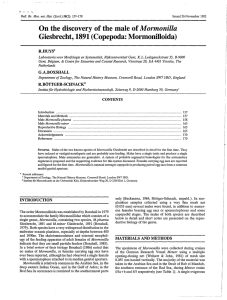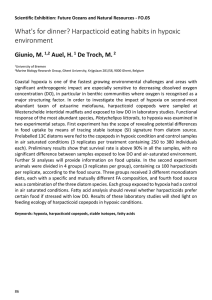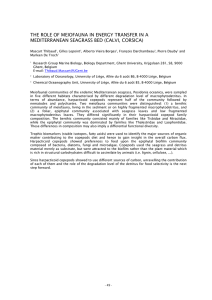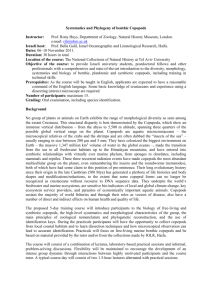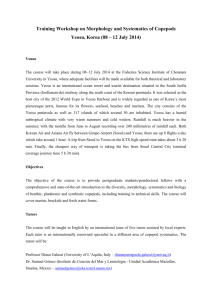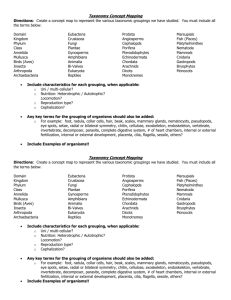A New Tantulocaridan (Crustacea: Maxillopoda) ... Calanoid, Harpacticoid and Cyclopoid Copepods
advertisement
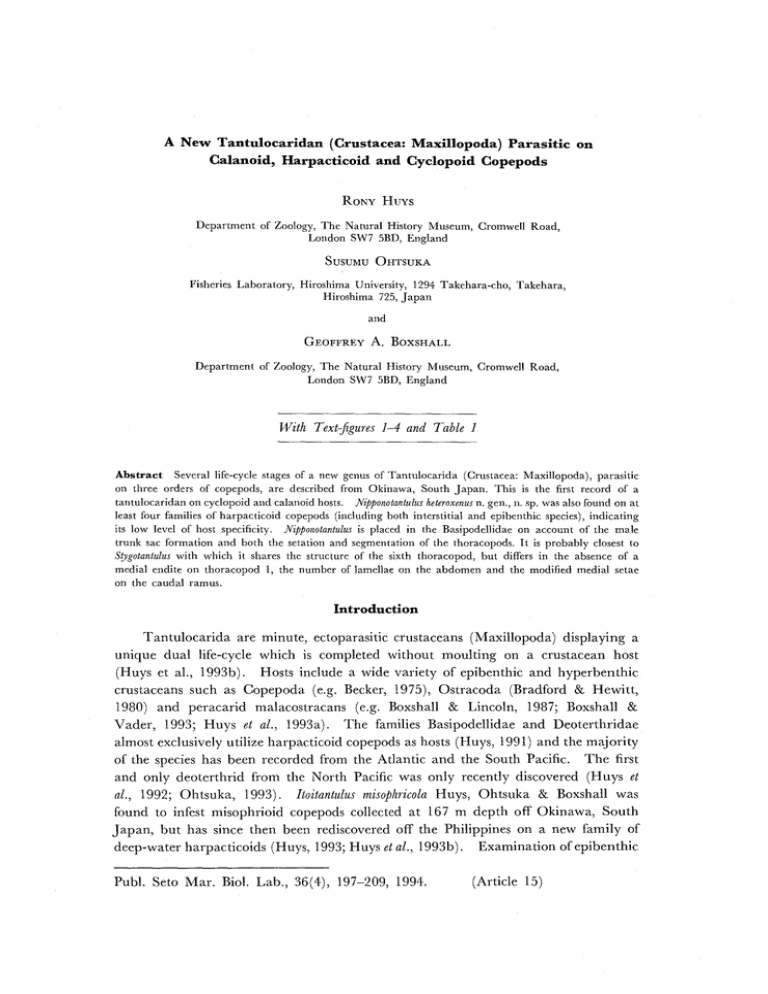
A New Tantulocaridan (Crustacea: Maxillopoda) Parasitic on Calanoid, Harpacticoid and Cyclopoid Copepods RoNY Huvs Department of Zoology, The Natural History Museum, Cromwell Road, London SW7 5BD, England SusuMu 0HTSUKA Fisheries Laboratory, Hiroshima University, 1294 Takehara-cho, Takehara, Hiroshima 725, Japan and GEOFFREY A. BoxsHALL Department of Zoology, The Natural History Museum, Cromwell Road, London SW7 5BD, England With Text-figures 1-4 and Table 1 Abstract Several life-cycle stages of a new genus of Tantulocarida (Crustacea: Maxillopoda), parasitic on three orders of copepods, are described from Okinawa, South Japan. This is the first record of a tantulocaridan on cyclopoid and calanoid hosts. Nipponotantulus heteroxenus n. gen., n. sp. was also found on at least four families of harpacticoid copepods (including both interstitial and epibenthic species), indicating its low level of host specificity. Nipponotantulus is placed in the Basipodellidae on account of the male trunk sac formation and both the setation and segmentation of the thoracopods. It is probably closest to Stygotantulus with which it shares the structure of the sixth thoracopod, but differs in the absence of a medial endite on thoracopod 1, the number of lamellae on the abdomen and the modified medial setae on the caudal ramus. Introduction Tantulocarida are minute, ectoparasitic crustaceans (Maxillopoda) displaying a unique dual life-cycle which is completed without moulting on a crustacean host (Huys et al., 1993b). Hosts include a wide variety of epibenthic and hyper benthic crustaceans such as Copepoda (e.g. Becker, 1975), Ostracoda (Bradford & Hewitt, 1980) and per acarid malacostracans (e.g. Boxshall & Lincoln, 1987; Boxshall & Vader, 1993; Huys et al., 1993a). The families Basipodellidae and Deoterthridae almost exclusively utilize harpacticoid copepods as hosts (Huys, 1991) and the majority of the species has been recorded from the Atlantic and the South Pacific. The first and only deoterthrid from the North Pacific was only recently discovered (Huys et al., 1992; Ohtsuka, 1993). ltoitantulus misophricola Huys, Ohtsuka & Boxshall was found to infest misophrioid copepods collected at 167 m depth off Okinawa, South Japan, but has since then been rediscovered off the Philippines on a new family of deep-water harpacticoids (Huys, 1993; Huys et al., 1993b). Examination of epibenthic Publ. Seto Mar. Bioi. Lab., 36(4), 197-209, 1994. (Article 15) 198 R. Huvs, S. 0HTSUKA & G.A. BoxsHALL and hyperbenthic copepods from dredge samples collected offNagannu Island revealed other tantulocaridans on calanoid, harpacticoid and cyclopoid copepods. One of the host harpacticoids has recently been described in a separate paper (Huys & Ohtsuka, 1993) but all other host species are as yet undescribed. The tantulocaridan material contained different developmental stages, however, despite the wide host range all specimens could be positively identified as belonging to the same new genus and species. This paper describes the various developmental stages of the second tantulocaridan to be found in Japanese waters and presents the first record of tantulocaridans infesting calanoid and cyclopoid copepods. Materials & Methods The host copepods were collected with a dredge from a sandy bottom off Nagannu Island, Okinawa, South Japan (see Ohtsuka & Boxshall, 1993) on 14 May 1991 (local time: 11.15-12.08) and on 9 April 1992 (local time: 07.37-08.18). The dredge was towed along the bottom at a speed of 2 knots by the T /RV Toyoshio-maru of Hiroshima University for about 5 minutes. Specimens were fixed in 10 % neutralized formalin/sea-water immediately upon collection. The tantulocaridans were examined and illustrated with differential interference contrast microscopes (Leitz Dialux 20, Leitz Diaplan, Olympus BH-2). Cephalic pore pattern terminology is adopted from Huys & Boxshall (in prep.). Systematics Family Basipodellidae Boxshall & Lincoln, 1983 Genus Nipponotantulus n. gen. Diagnosis. Tantulus larva comprising cephalon, 6 pedigerous thoracic somites and 2-segmented, limbless urosome. First thoracic somite almost completely concealed beneath posterior margin of dorsal cephalic shield. Cephalon with 4 longitudinal epicuticular lamellae dorsally and 4 transverse cuticular ridges ventrally. Cephalic pore formula: A1 _v, L 1 _ 1v, D1 _ 1v. Cephalic stylet almost straight. Thoracopods 1-5 biramous, with unsegmented protopod. Thoracopod I without endite; thoracopods 2 to 5 each with well-developed endite; exopods apparently 2-segmented with 2 (leg 1), 3 (legs 2 and 3) or 4 setae (legs 4 and 5) on distal segment; endopods ]-segmented without (leg 1) or with 2 setae (legs 2-5). Thoracopod 6 without distinct rami, with 2 terminal setae, inner one slightly chitinized and curved inwards. Abdomen with 3 transverse lamellae around the somite. Caudal ramus with 1 short and 2 modified, bifid setae. Hosts: Calanoida (Pseudocyclopiidae), Cyclopoida (Cyclopininae) and at least 4 different families of Harpacticoida. Etymology. The generic name is derived from the Latin nipponus, meaning Japanese, and tantulus, which forms part of the name of the subclass Tantulocarida. Type species. Nipponotantulus heteroxenus n. gen., n. sp. TANTULOCARIDAN ON COPEPODS 199 Nipponotantulus heteroxenus n. gen., n. sp. (Figs. 1-4) Type material. Type series consisting of specimens infesting Pseudocyclopiidae spp. (Calanoida) collected from a sandy bottom (46-49 m depth) off N agannu Island, Okinawa, South Japan (26°l4'N, 127o32'E; 9 April 1992), and deposited in the collections of the Natural History Museum, London. Holotype (reg. no. 1993.711 ): tantulus larva attached to urosome of second copepodid stage of unidentified Pseudocyclopiidae species (mounted on slide). Paratypes: 1 tantulus larva attached to caudal ramus of unidentified Pseudocyclopiidae species (on slide: reg. no. 1993.712); 1 6 at an early stage of development still enclosed in the tantulus sac, found on fifth pedigerous somite of adult 6 of Pseudocyclopia sp. (on slide: reg. no. 1993.713); 2 4242 at an early stage of development, each attached to the genital double-somite of an adult 42 of an undescribed new species of Paracyclopia (in alcohol: reg. no. 1993. 714-715). Illustrations based on holotype are Figs. lA-F. Description. Tantulus larva (Figs. lA-F). Body consisting of cephal on covered by dorsal shield, 6 pedigerous somites and 2-segmented limbless urosome; body length about 82 Jlm, measured from anterior tip of cephalon to posterior margin of caudal rami (Fig. !B). Cephalon (Figs. IC-E) tapering anteriorly with 4 pairs of transverse cuticular ridges anteroventrally (Fig. !D); posteriormost pair sometimes fused to form continuous ridge (Fig. 2E). Cephalic shield 1.3 times as long as wide (34 Jlm x 27 Jlm); 2 pairs of longitudinal epicuticular lamellae extending dorsally from posterior end of cephalon to anterior sensillum. Oral disc about 10 Jlm in diameter, anteroventrally positioned; partly covered anteriorly by membranous extension of cephalon (Figs. 1B, H). Ventral pores and M-pores missing. Cephalic pore formula as follows: A 1 _v, L 1 _ 1v, D 1 _ 1v. Cephalic stylet 24 Jlm long, more or less straight; hollow at base. Eight glandular structures (arranged in pairs) discernible in posterior half of cephalon (Figs. 1C, E); remnant of internal tubular structure connecting stalk of oral disc with medial dorsal surface of cuticle at about midway tip and basis of cephalon (Figs. lC, E). Thoracic somites 1 to 6 (Figs. lB, F) each provided with well developed tergite and pair of thoracopods. First tergite almost completely concealed beneath posterior rim of cephalon (Fig. lB). Tergites lacking distinct surface ornamentation, usually with 1 transverse surface lamella (Figs. lB, C; 3B, C). Thoracopods of the holotype similar to those of paratype male illustrated in Figs. 2B-D, F. Thoracopod 1 (Fig. 2B) with !-segmented protopod lacking medial endite. Endopod represented by digitiform segment which is slightly bifid apically. Exopod 2-segmented; proximal segment small, unarmed; distal segment with 2 terminal setae, outer seta being shorter than inner. Thoracopods 2 to 5 (Figs. 2C, D) similar, with large !-segmented protopod; medial endite lobate, with at least 2 minute spinules; outer margin of protopod with 1-3 protuberances, these being particularly pronounced in thoracopod 5. Endopod !-segmented, elongate, with 2 outer setae medially; apex with 2 processes. Exopod 2-segmented; proximal segment unarmed; distal segment with 3 (thoracopods 2 and 200 R. HuYs, S. 0HTSUKA & G.A. BoxsHALL 20 )J BE 100 )J A 100 )J G 50 )J H Fig. I. Nipponotantulus heteroxenus n. gen., n. sp. Tantulus larva (A-F); early stage 'f' (G,H). A. Tantulus larva attached to second urosomite of copepodid II of Pseudocyclopiidae sp.; B. Habitus, lateral view [setae on thoracopods l to 5 omitted]; C. Cephalon, dorsal view; D. Anterior half of cephalon, ventral view, showing 4 transverse cuticular ridges; E. Cephalon, lateral view, showing internal structures [surface ornamentation omitted]; F. Thoracic somites and urosome, dorsal view, urosome slightly bent dorsally; G. Early 'f' stage attached to genital double-somite of adult 'f' of Paracyclopia sp.; H. Same stage, lateral view [scar indicated by arrowhead]. T ANTULOCARIDAN ON COPEPODS 10 }J 8-D,F-H E G Fig. 2. Nipponotantulus heteroxenus n. gen., n. sp. Male at early stage of development. A. Male attached to fifth pedigerous somite of adult 6 of Pseudocydopia sp.; B. Thoracopod 1; C. Thoracopod 2; D. Thoracopod 5; E. Anterior half of body, ventral view, orai disc detached from cephalon [Arabic numerals indicating position of dorsal thoracic tergites]; F. Thoracopod 6; G. Urosome, ventral view; H. Same, lateral v1ew. 201 202 R. Huvs, S. 0HTSUKA & G.A. BoxsHALL 3) or 4 (thoracopods 4 and 5) setae terminally. Thoracopod 6 (Fig. 2F) with undivided protopod lacking endite, but having 2 coupling spinules midway the inner margin; outer and inner margins with I and 2 spinous processes, respectively; surface with transverse and longitudinal lamellae. Rami not distinct but probably represented each by a vestigial segment with a strong seta; inner seta shorter than outer, more or less chitinized and curved inwards. Urosome (Figs. lB, F; 2G, H) consisting of small seventh thoracic somite and large unsegmented abdomen, about 15 J.lm in length. Seventh thoracic somite tapering anteriorly, with one transverse lamella dorsally. Abdomen longer than wide, II J.lm long; tapering anteriorly, with 3 distinct, transverse lamellae and numerous minute longitudinal lamellae both ventrally and dorsally; ventral posterior margin with 1 pair of minute processes (Fig. 2G). Caudal rami small, each with 1 short dorsal setule and 2 long medial spiniform setae; medial setae modified, bifid in lateral aspect. Male metamorphosis (Figs. 2A, E). Male at early stage of development enclosed m reflexed position within expanded trunk sac of preceding tantulus larva; differentiation of tagmosis and thoracopods not discernible. Trunk sac expanded dorsally, with major swelling posterior to sixth tergite; additional swelling occurring between posterior rim of cephalon and first thoracic tergite (Figs. 2A; 3B). Cephalon, thoracopods and urosome unchanged from tantulus larva. Female metamorphosis (Figs. 1G, H). Female at early stage of development with larval thorax and abdomen sloughed, leaving ventral scar (arrowed in Fig. IH). Cephalic shield unchanged from preceding tantulus larva. Trunk sac contents not fully differentiated, connected via tissue strand with larval cephalon. Etymology. The specific name is derived from the Greek heteros, meaning other, and xenos, meaning host, and refers to the wide range of hosts infested by this tantulocaridan. Records on other copepod orders. 1. Cyclopoida A single male, at an early stage of development, was found attached to the posterior lateroventral margin of the genital double-somite of an adult female interstitial cyclopoid (Figs. 3A-C). The specimen was collected from a sandy deposit off Nagannu Island, Okinawa (26°l3.6'N, 127"32.6'E) at 52 m depth on May 14 1991, where also Platycopia orienta/is was collected (Ohtsuka & Boxshall, 1993). The host belongs to an as yet undescribed genus and species of Cyclopinidae (subfam. Cyclopininae). The male specimen differs slightly from the paratype male in the ornamentation of the abdomen and the length of the medial caudal ramus setae, but agrees in all other aspects with the description given above, including the cephalic pore pattern, the thoracopodal armature and the displacement pattern of the larval tergites. The subtle differences are regarded as part of the intraspecific variability and do not warrant the establishment of a distinct species. T ANTULOCARIDAN 0 N COPEPODS Fig. 3. , d elopmel1t. 11 d e . ofet ev Male at early stag 11 . sp. .· n+ ' of an as Y ul1describe Nzpponotan ,uaItme . heteroxenus .. Igen., double-somite o. f C.a d S dorsal view. I tulus attached to gemta lateral View, Ma e . 'd e· B. Same, A . . of Cycloplm a ' speoes 203 204 R. Huvs, S. 0HTSUKA & G.A. BoxsHALL Fig. 4. Nipponotantulus lzeteroxenus n. gen., n. sp. A. Early stage <;! attached to P5-bearing somite of adult <;! of an as yet undescribed genus and species of Paramesochridae; B. Stenocaris sp. adult <;! with early stage <;! attached to first free abdominal somite and isolated cephalic shield attached to anal somite [indicated by arrowhead]. T ANTULOCARIDAN ON COPE PODS 2. 205 Harpacticoida All host specimens were collected at the same site and date as the type senes (see above). a. Cylindropsyllidae Huys & Ohtsuka (1993) reported on two presumably parthenogenetic female stages found attached to the holotype and only male paratype of Syrticola intermedius Huys & Ohtsuka (subfamily Leptopontiinae). Since the entire postcephalic trunk is missing in both specimens, only the head shield is left for comparison and identification. Huys & Ohtsuka's illustrations (Figs. 5D-E) show a slightly different number of pores corresponding to an A1 _ 1v, 1 1 _ 111 , D 1 _ 1v formula. Re-examination revealed that the posteriormost dorsal pore and one of the lateral pores were overlooked. The absence of some of the sensilla and of the tiny longitudinal epicuticular lamellae do not reflect deficiencies in Huys & Ohtsuka's drawings but are merely artifacts caused by the overall deterioration of the larval cephalon upon successful attachment of the parasite. On the basis of the identical cephalic pore formula, size and general shape of the head shield, and the length of the cephalic stylet the early stage females on S. intermedius are identified as N. heteroxenus. Two specimens of N. heteroxenus were also discovered on another subfamily of Cylindropsyllidae. An adult female of Stenocaris sp. (subfamily Cylindropsyllinae) was found to be infested by an early stage female attached to the dorsal surface of the first free abdominal somite, and by a second specimen of which only the isolated head shield was left on the anal somite (Fig. 4B). The host harpacticoid is clearly related to S. kliei Kunz from the German Bight (Kunz, 1936) and S. arenicola Wilson from the Atlantic seaboard of the U.S.A. (Wilson, 1932), and represents the second cylindropsyllinid host for the group (Huys & Boxshall, 1988). Paramesochridae One female at an early stage of development was found attached to the dorsal wall of the P5-bearing somite of a paramesochrid copepod (Fig. 4A). Despite its largely undivided urosome the host specimen has been positively identified as an adult female of an as yet undescribed genus possibly related to Apodopsyllus Kunz and Caligopsyllus Kunz. b. c. Diosaccidae An isolated head shield was found on the left caudal ramus of a copepodid IV stage of an unidentifiable species of Amphiascus. This species is the second diosaccid to be recorded as host of tantulocaridans, the first being Stenhelia (Delavalia) sp. collected from Bass Strait and host of Deoterthron lincolni (Boxshall) (see Boxshall, 1988; Huys, 1990). Tetragonicipitidae One female early 111 transformation was found on the P2-bearing somite of a copepodid III stage of Tetragonicipitidae, possibly belonging to Tetragoniceps. d. 206 R. Huvs, S. 0HTSUKA & G.A. BoxsHALL Discussion. The affinities of the new genus seem to lie with the family Basipodellidae, encompassing two other copepod-infesting genera Basipodella Becker and Stygotantulus Boxshall & Huys. Evidence for this is found in the swelling pattern of the trunk sac containing the metamorphosing male (Figs. 3A-C). In all three genera the trunk sac is formed posterior to the larval thoracic tergite six with additional swelling noticeable between the posterior margin of the cephalon and the first thoracic tergite (Huys, 1990). Re-examination of the abdomen in B. hmpacticola and S. stocki revealed that the transverse annulations do not reflect somite boundaries but are mere surface ornamentation of a unisegmented abdomen as found in all other Tantulocarida (H uys & Boxshall, in prep.). These observations remove the significance of abdominal segmentation at the family level and allow Nipponotantulus to be placed in the Basipodellidae on the basis of other characters including the male trunk sac, the setation of thoracopod I (no setae on endopod, 2 setae on exopod) and thoracopods 2-5 (undivided protopod, exopod with 3 to 4 setae). N. heteroxenus appears to be most closely related to S. stocki which has a similar sixth thoracopod in the tantulus stage (Boxshall & Huys, 1989), however possesses four transverse lamellae on the abdomen, no modified setae on the caudal rami and a well developed lobate endite on the first thoracopod. The absence of the latter endite in Nipponotantulus is atypical, further being found only in both genera of the Microdajidae (Boxshall et al., 1989; Huys, 1991). In Itoitantulus misophricola the medial endite seems to be almost fully integrated in the protopod with the coupling spines arising directly from its medial margin (Huys et al., 1992). Perhaps the most distinctive feature of the new genus is the caudal ramus with its modified medial setae. A similar kind of modification has been recorded for Dicrotrichura tricincta Huys and I. misophricola (cf. Huys, 1989; Huys et al., 1992) but in these species the medial setae are composite, consisting of a rigid basal part serving as a setophore for the slender, flagellate, distal part. Considering the number of specimens examined, it is unlikely that this distal part is missing in N. heteroxenus. It appears that the spiniform element represents the entire seta and the presence of a dorsal spur on each of them only accentuates a superficial similarity to the bifid setae in Dicrotrichura and Itoitantulus. Since the discovery of Basipodella harpacticola by Becker in 197 5, several other tantulocaridans have been recorded from copepod hosts, particularly harpacticoids and most recently misophrioids (Huys et al., 1992; Ohtsuka, 1993). This is the first record of tantulocaridans utilizing Cyclopoida and Calanoida as hosts, and represents a considerable host range extension for Tantulocarida infesting copepods, probably suggesting that they might even be found on certain representatives of Poecilostomatoida and Siphonostomatoida that are only loosely associated with invertebrate hosts and live at the sediment-water interface. Tantulocarida are usually found on only a single host species but this might just be reflecting scant collecting. A few species have been reorded from different hosts (Table I) but the discovery of N. heteroxenus on 3 orders, 6 families and 9 207 TANTULOCARIDAN ON COPEPODS Table 1: Tantulocarida found on more than one host species. Tantulocaridan Host category Host family Stygotantulus stocki harpacticoids Canuellidae Unidentified Boxshall & Huys (1989) harpacticoids Tisbidimorph Unidentified Boxshall & Huys (1989) misophrioids Misophriidae Misophriopsis okinawensis Huys eta!. (1992), Ohtsuka harpacticoids Styracothoracidae Styracotlwrax gladiator Huys (1993), Huys eta!. (1993b) harpacticoids H untemanniidae Metahuntemannia peruana Becker (1975); Schriever harpacticoids Huntemanniidae lvfetahuntemannia magniceps (?) Becker (1975); Schriever ltoitantulus misophricola Host species References (1993) Basipodella harpacticola (in Grygier & Sieg, 1988) (in Grygier & Sieg, 1988) harpacticoids Unidentified Unidentified Becker (1975); Schriever tanaidaceans Lcptognathiidae Leptognathia breviremis Greve (1965, 1988); Sieg (1986); (in Grygier & Sieg, 1988) Microdajus langi Grygier & Sieg ( 1988); Boxshall eta/. (1989); Huys (1991) tanaidaceans Leptognathiidae Leptognatlzia gracilis Boxshall & Lincoln (1987) tanaidaceans Leptognathiidae llaplocope angusta Greve ( 1965) tanaidaceans Leptognathiidae T;phlotanais aequiremis Greve (1965) tanaidaceans Leptognathiidae Leptognathiopsis attenuata Boxshall & Lincoln (1987) tanaidaceans Anarthruridae Anarthrura simplex JVipponotantulus heteroxenus calanoids Pseudocyclopiidae Pseudoc_pclopia sp. Greve (1988) present account calanoids Pseudocyclopiidae Parac_pclopia sp. present account calanoids Pseudocyclopiidae Unidentified present account cyclopoids Cyclopinidae Unidentified present account harpacticoids Diosaccidae Amphiascus sp. present account harpacticoids Tetragonicipitidae Tetragoniceps sp. harpacticoids Paramesochridae Unidentified present account present account harpacticoids Cy1indropsyllidae Stenocaris sp. present account harpacticoids Cylindropsyllidae S;•rticola intermedius Huys & Ohtsuka (1993) species Is at least unexpected and a similarly high host diversity has only been recorded for Microdajus langi Greve found on 6 different tanaid species. The low host specificity of N. heteroxenus also indirectly supports the identification of the only sexual female specimen recently discovered in deep waters off the Philippines (Huys et al., 1993b). The identification of this life-cycle stage as the second record of Itoitantulus misophricola was provisional because Huys et al. ( 1993b) had to rely solely on larval head characters. The uncertainty about its identity was further reinforced by the wide vertical and horizontal separation of both records, but even more important, also by the fact that the same tantulocaridan species was found on hosts 208 R. Huvs, S. 0HTSUKA & G.A. BoxsHALL representing two different orders of copepods, Misophrioida (Misophriopsis okinawensis) and Harpacticoida (Styracothorax gladiator). The wide host range observed for N. heteroxenus in a relatively small sample, suggests that tantulocaridans can infest species that are not their usual hosts (xenoparasitism), and low host specificity does not necessarily provide conflicting evidence in tantulocaridan identification. With the discovery of the new species on a range of harpacticoid copepods, the number of families in this order infested by Tantulocarida has risen to II, including two unidentified ones (Schriever in Grygier & Sieg ( 1988); Boxshall & Huys, 1989). The majority of the harpacticoid hosts are typically epibenthic or hyperbenthic species living at or near the sediment-water interface. With the exception of Boreotantulus kunzi Huys & Boxshall found on Cylindropsyllus laevis Brady (cf. Huys & Boxshall, 1988), Tantulocarida have never been recorded again on genuinely interstitial copepods, however, the present discovery of N. heteroxenus on Cyclopinidae, Cylindropsyllidae and Paramesochridae suggests that this category is also susceptible to infection. N. heteroxenus is the second tantulocaridan to be reported from Japanese waters (Huys et al., 1992). Both the new species and I. misophricola were found in the Okinawa area and both were also frequently found on juvenile copepods, suggesting that Tantulocarida do not require adult hosts to complete their life-cycle. Boxshall & Lincoln (1987) assumed that tantulocaridans lack the ability to suppress moulting in the crustacean host and are shed along with the old exuvium when the parasite's life cycle is not completed prior to the next moult. Conversely, H uys (1991) regarded the presence of full-grown male parasites on copepodid stages as indicative for a moult inhibition mechanism. Based on development rate data for related harpacticoids, he calculated that the entire male pathway had to be completed in less than two days (!), unless other external factors such as temperature or food availability retarded the development of the host. Okinawa is situated in the subtropical zone and influenced by the warm Kuroshio current, and the numerous subtidal shallow habitats around the archipelago are far from oligotrophic. The high prevalence of various life-cycle stages, including adult parthenogenetic females (Ohtsuka, 1993), on immature hosts in this area appears to reinforce the existence of a parasite-mediated growth arrest mechanism - at least in species infesting copepods. Acknowledgements The captain and crew of the T/RV Toyoshio-maru (Hiroshima University), and E. Tsuchida (University of Tokyo), Y. Endo and M. Okada (both Hiroshima University) are gratefully acknowledged for their cooperation at sea. One of us (S.O.) wishes to extend his sincerest thanks to Prof. T. Onbe (Hiroshima University) for his continuous encouragement during the present study. We also like to thank Dr. R.J. Lincoln for his comments on the manuscript. R.H. is a Visiting Research Fellow at the Zoology Institute, University of Gent, Belgium. This work was partly supported by a grant of the Fujiwara Natural History Foundation awarded to S.O. TANTULOCARIDAN ON COPEPODS 209 References Becker, K.-H. 1975. Basipodella harpacticola n. gen., n. sp. (Crustacea, Copepoda). Helgol. w1ss. Meeresunters., 27: 96-100. Boxshall, G.A. 1988. A new genus of tantulocaridan (Crustacea: Tantulocarida) parasitic on a harpacticoid copepod from Tasmania. Bull. Br. Mus. nat. Hist. (Zoo!.), 54: 271-274. & R. Huys. 1989. New tantulocarid, Stygotantulus stocki, parasitic on harpacticoid copepods, with an analysis of the phylogenetic relationships within the Maxillopoda. J. crust. Bioi., 9: 126-140. - - - - & R.J. Lincoln. 1987. The life cycle of the Tantulocarida (Crustacea). Phil. Trans. roy. Soc. London, B. Biological Sciences, 315: 267-303. - - - - & W. Vader. 1993. A new genus ofTantulocarida (Crustacea) parasitic on an amphipod host from the North Sea. J. nat. Hist., 27: 977-988. - - - - , R. Huys & R.J. Lincoln. 1989. A new species of Microdajus parasitic on a tanaid in the northeastern Atlantic, with observations on M.. langi Greve. Syst. Parasit., 14: 17-30. Bradford, J.M. & H.C. Hewitt. 1980. A new maxillopodan crustacean, parasitic on a myodocopid ostracod. Crustaceana, 38: 67-72. Greve, L. 1965. A new epicaridean from western Norway, parasite on Tanaidacea. Sarsia, 20: 15-19. - - - - . 1988. Litt om klassen Tantulocarida (Crustacea) -en gruppe orsma krepsdyrparasitter. Fauna, Oslo, 41: 12-15. Grygier, M.J. & J. Sieg. 1988. AJicrodajus (Crustacea: Tantulocarida) parasitic on an Antarctic tanaidacean, and a range extension of M. langi Greve.]. nat. Hist., 22: 1495-1505. Huys, R. 1989. Dicrotrichura tricincta gen. et spec. nov.: A new tantulocaridan (Crustacea: Maxillopoda) from the Mediterranean deep waters off Corsica. Bijdr. Dierk., 59: 243-249. - - - - . 1990. Campyloxiphos dineti gen. ct spec. nov. from off Namibia and a redefinition of the Deoterthridae Boxshall & Lincoln (Crustacea: Tantulocarida). J. nat. Hist., 24: 415-432. - - - - . 1991. Tantulocarida (Crustacea: Maxillopoda): a new taxon from the temporary meiobenthos. P.S.Z.N.l.: Mar. Ecol., 12: 1-34. - - - - . 1993. Styracothoracidae (Copepoda: Harpacticoida), a new family from the Philippine deep sea. J. crust. Bioi., 13: 769-783. & G.A. Boxshall. 1988. A new genus and species of tantulocaridan (Crustacea: Tantulocarida) parasitic on a harpacticoid copepod from the Skagerrak. Sarsia, 73: 205-211. - - - - & S. Ohtsuka. 1993. A new species of Syrticola Willems & Claeys, 1982. (Copepoda: Harpacticoida) from] a pan with notes on the type species. Bull. nat. Hist. Mus. (Zoo!.), 59: 83-94. - - - - , G.A. Boxshall & J.-P. Casanova. 1993a. A redescription of Cumoniscus Bonnier, 1903 (Crustacea: Tantulocarida) from a cumacean host in the bay of Biscay. Syst. Parasit., 26: 75-79. - - - - & R.J. Lincoln. 1993b. The tantulocaridan life cycle: the circle closed? J. crust. Bioi., 13: 432-442. - - - - . , S. Ohtsuka, G.A. Boxshall & T. Ito. 1992. Itoitantulus misophricola gen. et sp. nov.: First record of Tantulocarida (Crustacea: Maxillopoda) in the North Pacific region. Zoo!. Sci., 9:875-886. Kunz. H. 1936. Neue Harpacticoiden (Crustacea Copepoda) von Helgoland (Vorlaufige Mitteilung). Kieler Meeresforsch., 1: 352-358. Ohtsuka, S. 1993. Note on mature female of Itoitantulus misophricola Huys, Ohtsuka and Boxshall, 1992 (Crustacea: Tantulocarida). Pub!. Seto. Mar. Bioi. Lab., 36: 73-77. & G.A. Boxshall. 1994. Platycopia orienta/is, new species (Copepoda: Platycopioida), from the North Pacific, with descriptions of copepodid stages. ]. crust. Bioi., 14: 151-167. Sieg. J. 1986. Tanaidacea (Crustacea) von der Antarktis und Subantarktis. II. Tanaidacea gesammclt von Dr. J.W. Wagele wahrend der Deutschen Antarktis Expedition 1983. Mitt. Zoo!. Mus. Univ. Kid, 2 (4): 1-80. Wilson, C.B. 1932. The copepods of the Woods Hole region, Massachusetts. Bull. U.S. natn. Mus., 158: 1-635.
